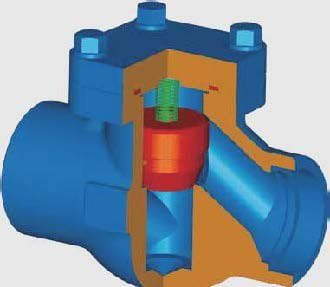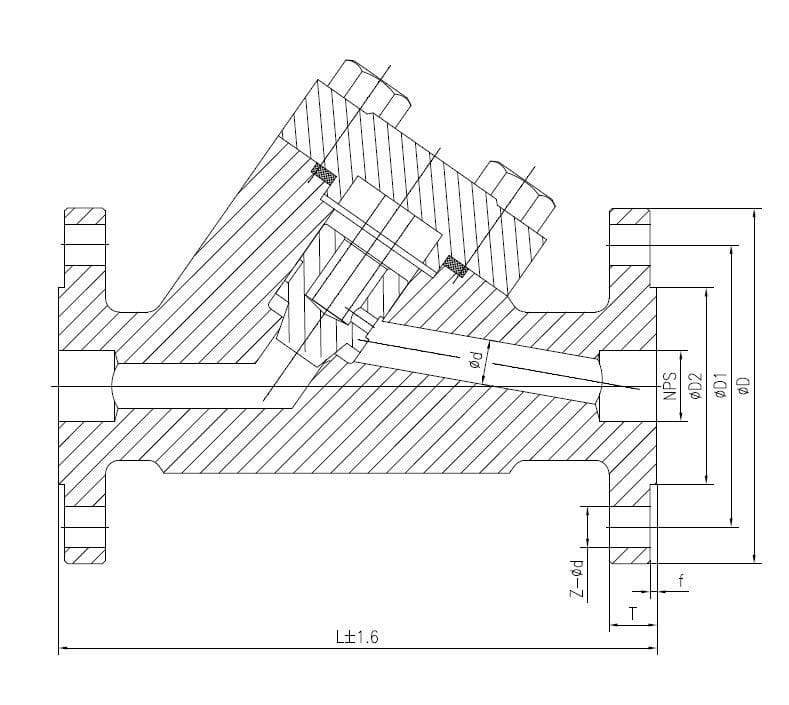What Is the Cracking Pressure of Check Valves?
May 19, 2023
Check valves are used in a wide range of industrial processes. While selecting the correct check valve design and materials for your application is important, it can be equally important to pay attention to what differential pressure is required to open the check valve.

Spring-loaded check valves have a spring that is activated by the pressures in the media, which open and close the valve. In spring-loaded check valves, the cracking pressure is determined by the spring setting and orientation of flow through the check valve. Swing check valves, however, use a flapper that swings off the seat to allow forward flow and then swings back to the seat when the flow is stopped (Learn more about the differences between spring-loaded check valves and swing check valves). With spring-loaded check valves, it may be possible for the spring (and the resulting net cracking pressure) to be tailored to the application. Typically, with swing check valves you are limited to the weight of the flapper or checking mechanism.
Spring-loaded check valves can be built with springs to allow flow in any orientation while most swing checks are not suitable for flow vertically up or vertically down through the valve. Additionally, the use of a spring check valve minimizes water hammer.
Ultimately, if you need a check valve that will allow you to select the cracking pressure to meet the needs of your application, then a spring-loaded check valve is preferred.
What is Cracking Pressure?
Often measured in pounds per square inch (PSI), cracking pressure is the difference in pressure between the valve's inlet and outlet ports. It's the pressure differential required to "crack" open the valve (the point at which there is a sudden rise in flow). It's also sometimes called the spring setting. If the cracking pressure is too high the valve will not fully open. If it is operating partially open the valve check mechanism may rattle and chatter, which can cause excessive wear and premature valve failure. This can result in the check mechanism failing to operate, coming apart with components traveling up or downstream (which can destroy valuable equipment), and preventing the function of stopping reverse flow.
Effects of Vertical Installation on the Cracking Pressure
Most spring-loaded check valves have a minimum recommended net cracking pressure; however, the cracking pressure is affected by vertical flow orientation. If the flow direction is vertical down, gravity pulls the weight of the trim components against the valve spring. This reduces the net cracking pressure, which may cause the valve to open or fail to return closed. In these cases, the spring selected must be heavy enough to support the weight of the trim, any column of liquid or media desired to be retained and achieve the minimum net cracking pressure. If you install a spring-loaded check valve in a vertical flow-up orientation, then the weight of the trim components would increase the amount of force required to open the check valve. Your net cracking pressure will be the combination of the trim weight, the spring, and any fluid column above the check valve.
When you're designing a system for automatic flow control the design of your check valve matters and the correct cracking pressure can be crucial. Working with a manufacturer that can tailor check valves to your application can be the difference between a low-maintenance, properly functioning system, or one that requires frequent maintenance and sub-par performance.
Design Method to Reduce Cracking Pressure
To make the valve more fast in response to the fluid, sometime client need a very low cracking pressure, due to the weight and force of the spring, normally there is a limitation to reducing it. To meet client requests, can use the below design:
1. Use a Y Pattern Piston Check Valve instead of the T pattern to reduce the gravity impact of the disc.


2. Special design without using spring.

If you need any support please contact Bosseal team.

Spring-loaded check valves have a spring that is activated by the pressures in the media, which open and close the valve. In spring-loaded check valves, the cracking pressure is determined by the spring setting and orientation of flow through the check valve. Swing check valves, however, use a flapper that swings off the seat to allow forward flow and then swings back to the seat when the flow is stopped (Learn more about the differences between spring-loaded check valves and swing check valves). With spring-loaded check valves, it may be possible for the spring (and the resulting net cracking pressure) to be tailored to the application. Typically, with swing check valves you are limited to the weight of the flapper or checking mechanism.
Spring-loaded check valves can be built with springs to allow flow in any orientation while most swing checks are not suitable for flow vertically up or vertically down through the valve. Additionally, the use of a spring check valve minimizes water hammer.
Ultimately, if you need a check valve that will allow you to select the cracking pressure to meet the needs of your application, then a spring-loaded check valve is preferred.
What is Cracking Pressure?
Often measured in pounds per square inch (PSI), cracking pressure is the difference in pressure between the valve's inlet and outlet ports. It's the pressure differential required to "crack" open the valve (the point at which there is a sudden rise in flow). It's also sometimes called the spring setting. If the cracking pressure is too high the valve will not fully open. If it is operating partially open the valve check mechanism may rattle and chatter, which can cause excessive wear and premature valve failure. This can result in the check mechanism failing to operate, coming apart with components traveling up or downstream (which can destroy valuable equipment), and preventing the function of stopping reverse flow.
Effects of Vertical Installation on the Cracking Pressure
Most spring-loaded check valves have a minimum recommended net cracking pressure; however, the cracking pressure is affected by vertical flow orientation. If the flow direction is vertical down, gravity pulls the weight of the trim components against the valve spring. This reduces the net cracking pressure, which may cause the valve to open or fail to return closed. In these cases, the spring selected must be heavy enough to support the weight of the trim, any column of liquid or media desired to be retained and achieve the minimum net cracking pressure. If you install a spring-loaded check valve in a vertical flow-up orientation, then the weight of the trim components would increase the amount of force required to open the check valve. Your net cracking pressure will be the combination of the trim weight, the spring, and any fluid column above the check valve.
When you're designing a system for automatic flow control the design of your check valve matters and the correct cracking pressure can be crucial. Working with a manufacturer that can tailor check valves to your application can be the difference between a low-maintenance, properly functioning system, or one that requires frequent maintenance and sub-par performance.
Design Method to Reduce Cracking Pressure
To make the valve more fast in response to the fluid, sometime client need a very low cracking pressure, due to the weight and force of the spring, normally there is a limitation to reducing it. To meet client requests, can use the below design:
1. Use a Y Pattern Piston Check Valve instead of the T pattern to reduce the gravity impact of the disc.


2. Special design without using spring.

If you need any support please contact Bosseal team.
Next: What‘s the advantage of Nickel-Aluminium Bronze Valves?
Previous: DN2000 Expansion Joint Start Working for Ho Chi Minh Main Water Supply Line
About Us
Categories
Useful Links
Our Contacts
Building 2, NO.59, Songshan Road, SND, Suzhou, China
